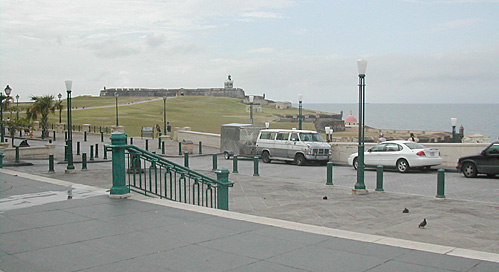
From the moment a Spanish settlement named Puerto Rico was established on the north coast of San Juan Bautista island (in later centuries the names of the capital and the island were interchanged), its location at the gateway to the New World made it desired by friend and foe alike.
The approach from Plaza del Quinto Centenario.
Castillo San Felipe del Morro in San Juan is part of the largest and best-preserved Spanish Castle fortifications in the New World. Sited at the entrance to San Juan Bay to protect the cityfrom sea attacks, it served as the gateway to New Spain. Construction started in 1540, but it took 250 years to take its present form. It has 6 levels, a height of 140 feet and has walls up to 20 feet thick. The fort has been a unit of the US National Park Service since 1949 and a World Heritage Site since 1983.
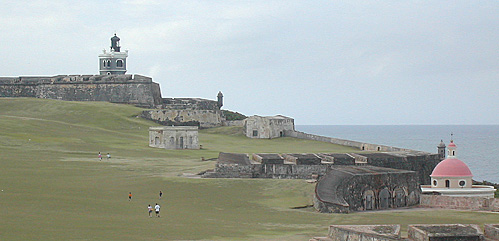 SPANISH DEFENCE in 1595
SPANISH DEFENCE in 1595
Learning of a treasure-laden Spanish galleon in Puerto Rico's bay, the English sea captain Francis Drake led a fleet of 27 ships manned by 2,500 men to attack the harbour settlement. Garrison soldiers fired cannons from the sea-level battery and the large hornwork on the promontory of El Morro, holding invading forces at bay.
The folks walking on the grounds of the park give an idea of the scale of El Morro.
One unconfirmed report stated a cannonball ripped through Drake's cabin, splintered a stool from under him, and killed two men. After several days of failed attempts to penetrate defences, resulting in many casualties, Drake sailed away.
 BRITISH CAPTURE PUERTO RICO in 1598
BRITISH CAPTURE PUERTO RICO in 1598
Learning from Captain Drake's mistakes three years ago, the British Earl of Cumberland and a 1,700-man army avoided the harbour. Instead, he anchored his fleet of 21 ships east of the settlement and entered along the San Antonio Bridge. The outnumbered Spanish soldiers fought valiantly, but unsuccessfully.
At right, the San Juan cemetery.
Several months later, summer heat contaminated food supplies and the resulting dysentery killed more than 400 soldiers and sickened another 400. Cumberland and his remaining men retreated, burning and looting as they went.
DUTCH ROUTED in 1625
Boudewijn Hendricksz and his fleet of 17 Dutch ships sailed directly into El Morro's cannons, gaining entrance to the harbour. Residents fled while El Morro's defenders led by Governor Juan de Haro withstood the siege. After 21 days of battle, the Dutch withdrew after sacking and burning the town to the ground.
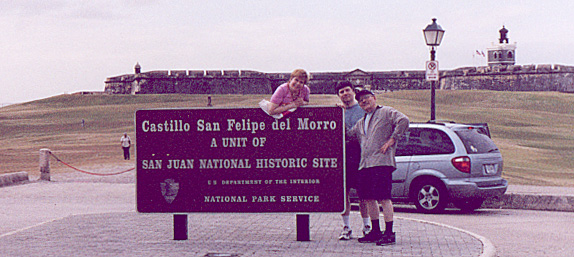
Three of the four tourists that entered El Morro (l to r): Wynter Lockwood (sister), Russ Lockwood, and Alfred Lockwood (father).
BRITISH REPULSED in 1797
San Juan, now a city of 62 acres situated within 200 acres of castles and walls and more than 450 mounted guns, was placed under siege by 3000 troops commanded by Ralph Abercromby. Spanish artillery crews wreaked havoc on English lines and after 17 days, the British sailed away in defeat.
Abercromby reported that San Juan could have resisted an army ten times larger than his invasion force.
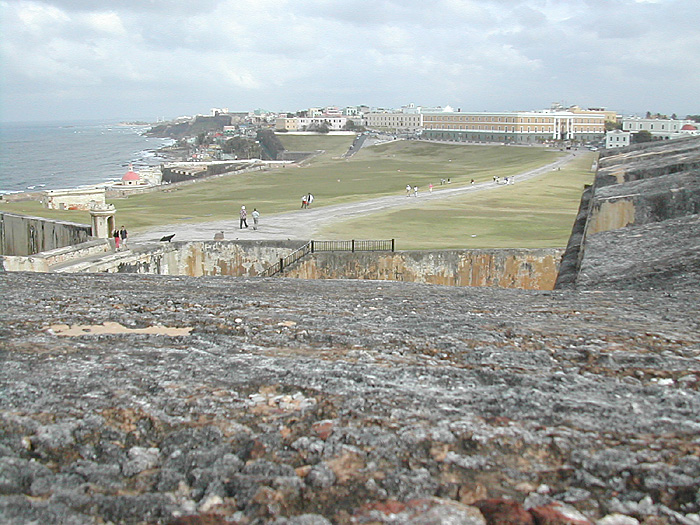
The entryway from the top of the walls, looking east along the coast. The sign above is at the upper right of the photo. The Plaza del Quinto Centenario is at center top.
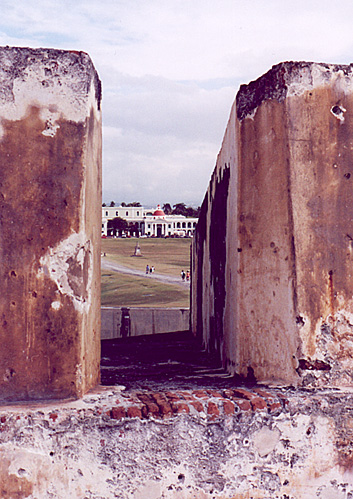 ENTRY
ENTRY
Entrance to the fort is gained via a long path to the front gates. According to the map, parking is by the Plaza del Quinto Centenario, but there's no reason to bring a car into Old San Juan. Buses from the main tourist hotels about 2-3 miles down the coast cost 50 cents and run regularly. Taxi rides cost $8-$10. The town is only a mile or so in length and a 1/2 mile or so in width, and walking is the best way to see the place...including ambling up to the fort.
The entryway from the top of the walls, looking south. The width of the cannon embrasure is approximately 2-3 feet, flaring out at a downward angle to a width of about 5-6 feet and to a length of roughly 10-12 feet. I did not measure it, as the other end of the wall is a sheer 80-90 foot drop off into a dry moat...and no railing or other barrier to prevent the fumble-footed from plummeting to their death.
Thick walls and wide open spaces make this a formidable fortification. The scale dwarfs everything around it. No wonder the various invaders found it a tough nut to crack and take. Today, a $5 or $6 entry fee gets you in.
Castle San Felipe del Morro (El Morro) San Juan, Puerto Rico
- Four Attacks: 1595-1797
El Morro Walking Tour: Main Plaza
El Morro Walking Tour: Bastion de Austria
El Morro Walking Tour: Bastion de Ochoa
El Morro Walking Tour: Battery del Carmen
El Morro Walking Tour: Artillery Ramp
El Morro Walking Tour: Battery de Santa Barbara
El Morro Walking Tour: Garita (Sentry Boxes)
El Morro Walking Tour: Lower Level
El Morro Walking Tour: Promenade (Outside Fort)
El Morro Walking Tour: Map of Upper Levels
El Morro Walking Tour: Map of Lower Levels
Back to List of Historic Sites
Back to Travel Master List
Back to MagWeb Master List of Magazines
© Copyright 2005 by Coalition Web, Inc.
This article appears in MagWeb.com (Magazine Web) on the Internet World Wide Web.
Other articles covering military history and related topics are available at http://www.magweb.com